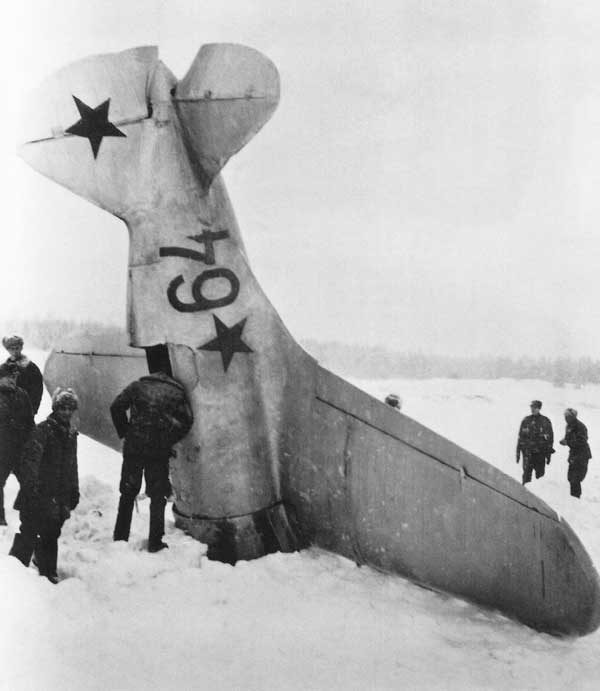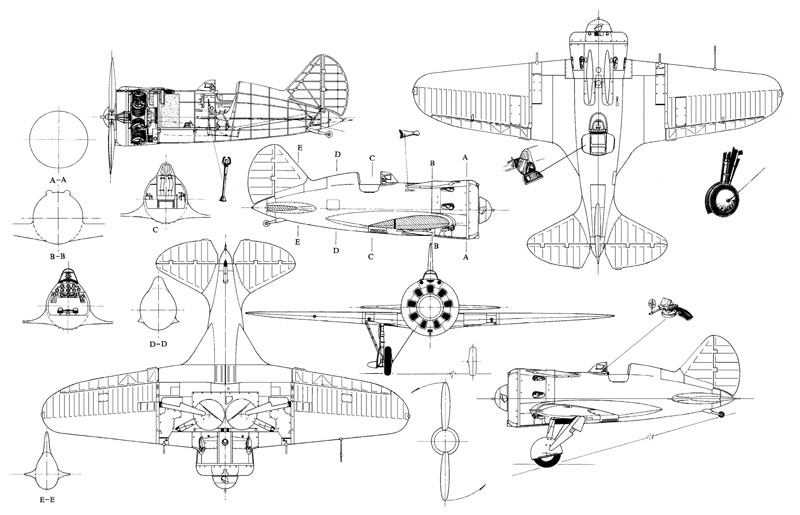Polikarpov I - 16
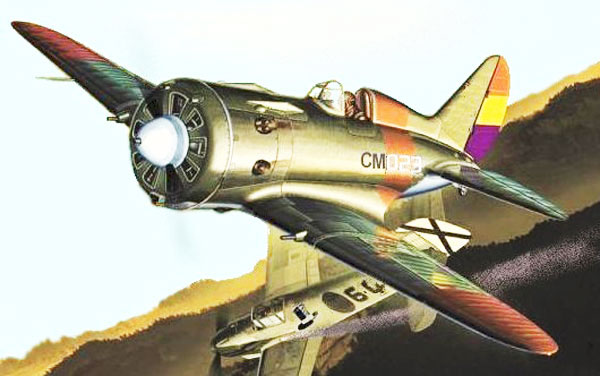
I have to offer a correction to the information that you have listed for the Poliparkov I-16, which is claimed to be the first cantilever-winged monoplane fighter with retractable gear, going into production in May 1934. However, not only did the P-30 go into production earlier, in January 1934, but was far more advanced in construction. Unlike the I-16, the P-30 was of all-metal construction, had a fully-enclosed cockpit, and a turbocharger for its V-1710 engine to boot. Although its P-26 stablemate was marginally faster below about 9,000 feet, at medium and high altitudes the P-30 would easily walk away from the Peashooter, or anything else in its day....Best regards...Ron Easley
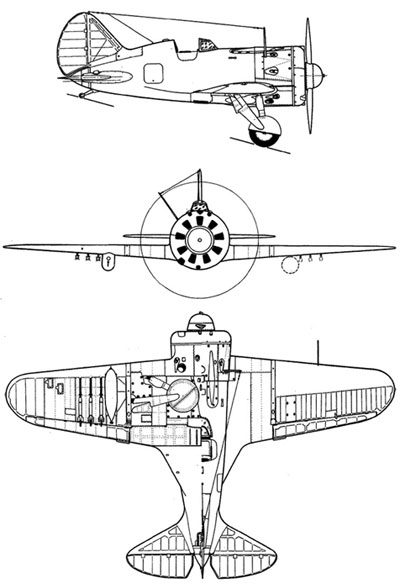
Polikarpov I-16 Rata
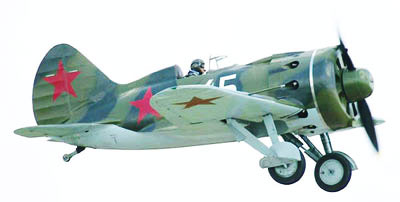 A tiny monoplane whose achievements totally belied its size, the I-16 was the first fighter anywhere to mount an 20-mm cannon. Blooded in Spain where it was dubbed Rata (Rat) the I-16's nickname followed it into the Second World War and it became synonymous with Russian tenacity in the air, its pilots ramming the enemy if all other tactics failed.
A tiny monoplane whose achievements totally belied its size, the I-16 was the first fighter anywhere to mount an 20-mm cannon. Blooded in Spain where it was dubbed Rata (Rat) the I-16's nickname followed it into the Second World War and it became synonymous with Russian tenacity in the air, its pilots ramming the enemy if all other tactics failed.
Conceived during the 1930s 'biplane versus monoplane ' years when nobody was quite sure which configuration would be most effective in actual combat in the future, the I-16 was a remarkable aircraft.
In 1933, Polikarpov decided to opt for a monoplane and he created the smallest possible airframe using mixed materials and it became the leading Soviet fighter for nearly a decade.That this was a little too long was shown after the Germans invaded in June 1911, the I-16 being declared obsolete the same month.
The first I-16 flew on December 31,1933, the low power of the M-22 engine being duly noted. There was no alternative powerplant unfortunately although the second example was flown in 1934 with an imported US Cyclone F3 engine.
Production went ahead in May 1934 despite the I-16's shortcomings which included a lack of trimmers, stability best described as marginal, wi a tendency to stall, and engine vibration. A two-seat unarmed trainer was built as UTI02, the fuselage of the model being used as a basis for the UTI-3 trainer. Other trainers conversions followed, based on later Rata models.
The main first production I-16 was the type - 4 which had a slightly longer cowling, a Hamilton propeller and other changes.The armored I-16Sh was a ground attack variant, with four ShKAS cannon and a 220 lb bomb load. In 1938 the I-16P appeared with long-barrelled wing cannon. This configuration, along with the fuselage guns, became the standard armament of the succeeding Type 17 and later models.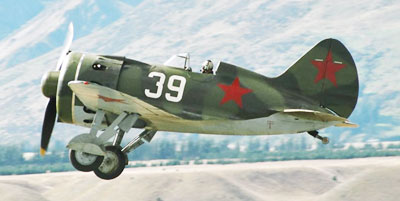
The I-16's model designations extended to the Type 24, 27, 29, and 30, production continuing throughout 1939 and into 1941. Most of these were powered by the M-62 or M-63 engine and all late-production I-16s had a variety of armament options, including RS-82 rockets under the wings or a bomb load of 1,102 lb.
In service the Rata or Mosca (Fly) could be a formidable opponent, as some German airmen found to their cost - if they could not bring enemy bombers down by conventional means, some Russian pilots would attempt to ram their adversaries which invariably resulted in the loss of both aircraft involved. this air combat tactic, born out of desperation in the early days of Barbarossa, was know as a 'Taran' or ramming victory. The first occurred when an I-16 rammed an He 111 one hour after the German invasion began. In this case the Rata pilot was killed although physical contact with enemy aircraft did not always result in the demise of the Russian pilot. And of course it was not confined to pilots flight the I-16!
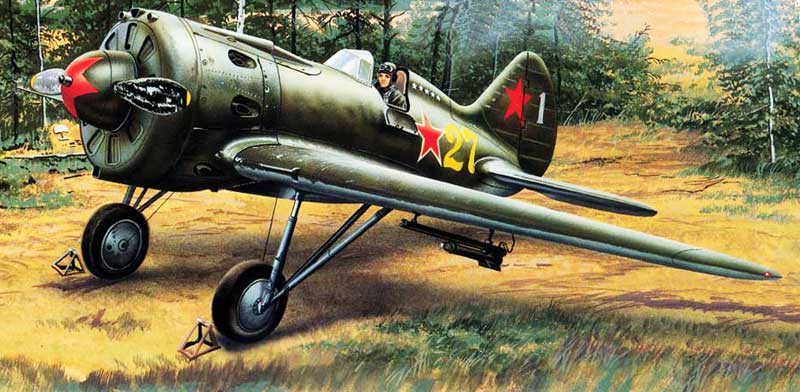
Polikarpov I-16 Rata/Mosca
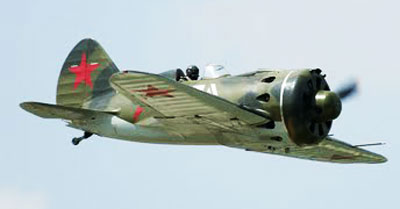 The Polikarpov I-16 was a Soviet fighter aircraft of revolutionary design; it was the world's first cantilever-winged monoplane fighter with retractable landing gear. The I-16 was introduced in the mid-1930s and formed the backbone of the Soviet Air Force at the beginning of World War II. The diminutive fighter prominently featured in the Second Sino-Japanese War, the Spanish Civil War where it was called the Rata (Rat) by the Nationalists or Mosca (Fly) by the Republicans, and the Battle of Khalkhin Gol. The Finnish nickname for I-16 was Siipiorava ("Flying Squirrel").
The Polikarpov I-16 was a Soviet fighter aircraft of revolutionary design; it was the world's first cantilever-winged monoplane fighter with retractable landing gear. The I-16 was introduced in the mid-1930s and formed the backbone of the Soviet Air Force at the beginning of World War II. The diminutive fighter prominently featured in the Second Sino-Japanese War, the Spanish Civil War where it was called the Rata (Rat) by the Nationalists or Mosca (Fly) by the Republicans, and the Battle of Khalkhin Gol. The Finnish nickname for I-16 was Siipiorava ("Flying Squirrel").
Design and development
While working on the Polikarpov I-15 biplane, Nikolai Nikolaevich Polikarpov began designing an advanced monoplane fighter. It featured cutting-edge innovations such as retractable landing gear and a fully enclosed cockpit, and was optimized for speed with a short stubby fuselage (similar to Gee Bee R-1) and a Wright Cyclone radial engine in a NACA cowling. The aircraft was small, light and simple to build.
Full scale work on the TsKB-12 prototype began in June 1933 and the aircraft was accepted into production on 22 November 1933, a month before it took to the air. The TsKB-12 was of mixed construction using a wooden monocoque fuselage and wings based around a KhMA chrome-molybdenum steel alloy wing spar, dural ribs and D1 aluminum alloy skinning on the center and leading edges, with the remaining portions of the wings fabric covered. Another modern feature were the ailerons which ran almost the entire trailing edge of the wing and also operated as flaps (in the manner of more modern flaperons) by drooping 15°. The cockpit was covered by a 16 in wide canopy which featured an Aldis tubular gun sight which could slide back and forth on runners fitted with bungee cords of rubber. A 59.4 US gal fuel tank was fitted directly in front of the cockpit. The main gear was fully retractable by a hand-crank. The armament consisted of a pair of 7.62 mm (0.30 in) ShKAS machine guns in the wings, mounted on the outboard side of the main gear and carried 900 rounds of ammo.
These features were proposed at first by Andrei N. Tupolev, however the NII V-VS was more concerned about the stresses a typical combat aircraft was subjected to in combat, and initially considered the risk too great. However TsAGI, with the help of the 3rd Design Brigade under the leadership of Pavel O. Sukhoi and Aleksandr P. Putylov eventually convinced NII V-VS that what was being proposed was not only feasible, but would enhance the aircraft's performance.
The TsKB-12 was designed around the Wright Cyclone SR-1820-F-3 nine cylinder radial engine (rated at 710 hp); a license to build this engine was being negotiated. As the license was not yet approved, Polikarpov was asked to settle for the less powerful M-22 (Soviet-built version of the Gnome-Rhone Jupiter 9ASB which itself was a licensed version of the Bristol Jupiter VI ) with 480 hp. This was deemed acceptable because the projected top speed still exceeded 185 mph.
The M-22 powered TsKB-12 first took to the air on 30 December 1933 with the famous Soviet test pilot Valery Chkalov at the controls. The second TsKB-12 with a Cyclone engine and three-bladed propeller flew in January of the following year. Initial government trials in February 1934 revealed very good maneuverability but the aircraft did not tolerate abrupt control inputs. Thus the TsKB-12 was deemed dangerous to fly and all aerobatics were forbidden. The M-22 version was preferred due to vibration of the Cyclone-powered aircraft. Pilots commented early on about difficulty in climbing into the cockpit, a trait that persisted through I-16's service life. Before continuing test flights the designers had to answer the question of spin behavior. Wind tunnel testing suggested that TsKB-12 with its short tail would enter an unrecoverable flat spin, but real-life trials were necessary to confirm this. Since Cyclone engines were rare it was decided to risk the M-22 prototype for this purpose. On 1 March and 2 March 1934, Chkalov performed 75 spins and discovered that the aircraft had very benign stall behavior (dipping a wing and recovering without input from the pilot when airspeed increased) and intentional spins could be easily terminated by placing controls in the neutral position. The stories of vicious spin behavior of the I-16 perpetuated in modern literature is unfounded (perhaps extrapolated from Gee Bee experience). In fact, the I-16's stablemate, the biplane Polikarpov I-153, exhibited much worse spin characteristics.
Service trials of the new fighter, designated I-16, began on 22 March 1934. The M-22 prototype reached 223 mph. The manually-retracted landing gear was prone to jamming and required considerable strength from the pilot. Most of the test flights were performed with the gear extended. 1 May 1934, the M-22 prototype participated in the flyover of the Red Square. Approximately 30 I-16 Type 1 aircraft were delivered, but were not assigned to any V-VS fighter eskadriliya. Most pilots who flew the I-16 Type 1 for evaluation purposes did not find the plane to have any redeeming characteristics. Regardless of pilot opinion, much attention was focused on the Cyclone powered aircraft and the M-25 (the license built Cyclone). On 14 April 1934, the Cyclone prototype was damaged when one of the landing gear legs collapsed while it was taxiing.
The third prototype with a Cyclone engine incorporated a series of aerodynamic improvements and was delivered for government trials on 7 September 1934. The top speed of 270 mph no longer satisfied the Air Force, who now wanted the experimental Nazarov M-58 engine and 290 mph. Subsequently, the M-22 powered version entered production at Factory 21 in Nizhny Novgorod and Factory 39 in Moscow. Because it was the fourth aircraft produced by these factories it received the designation I-16 Type 4. Type 4 aircraft fitted with these new engines required a slightly changed airframe, these changes included armour plating for the pilot and changes to the retract doors to allow for complete closure.
The M-25 fitted I-16, the I-16 Type 5, featured more changes, including a new engine cowling which was slightly smaller in diameter, had nine forward facing shuttered openings to control cooling flow and a redesigned exhaust with eight individual outlet stubs. The M-25 was rated at 635 hp at sea level and 700 hp at (7,546 ft. Due to the poor quality of the canopy glazing, the I-16 Type 5 pilots typically left the canopy open or removed the rear portion completely. By the time the Type 5 arrived, it was the world's lightest production fighter (3,219 lb), as well as the worlds fastest, able to reach speeds of 282 mph at altitude and 245 mph at sea level. While the Type 5 could not perform the high-g maneuvers of other fighters, it possessed superior speed and climb rates, and had extremely responsive aileron control which gave the Type 5 a very good roll rate which lead to precision maneuvers in loops and split-Ss.
A total of 7,005 single-seat and 1,639 two-seat trainer variants were produced.
Specifications
Length: 20 ft 1 in Performance: Armament: |
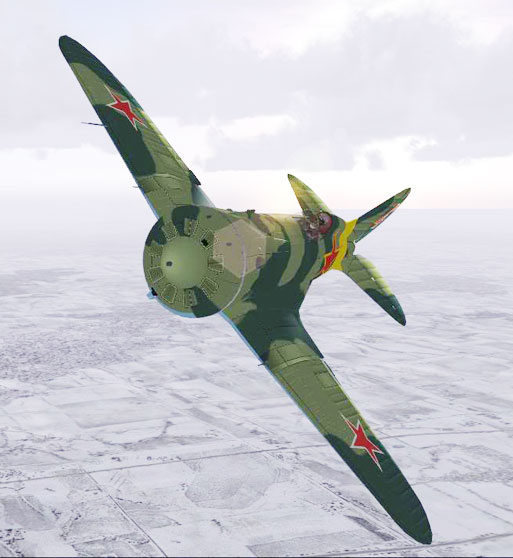
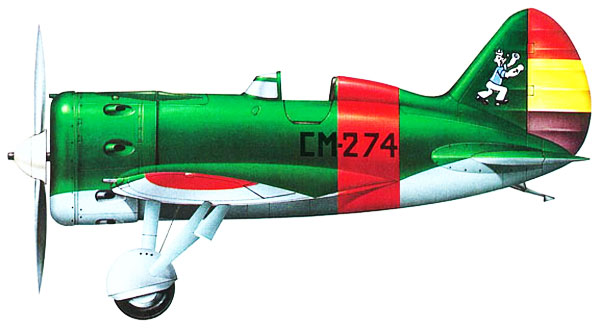
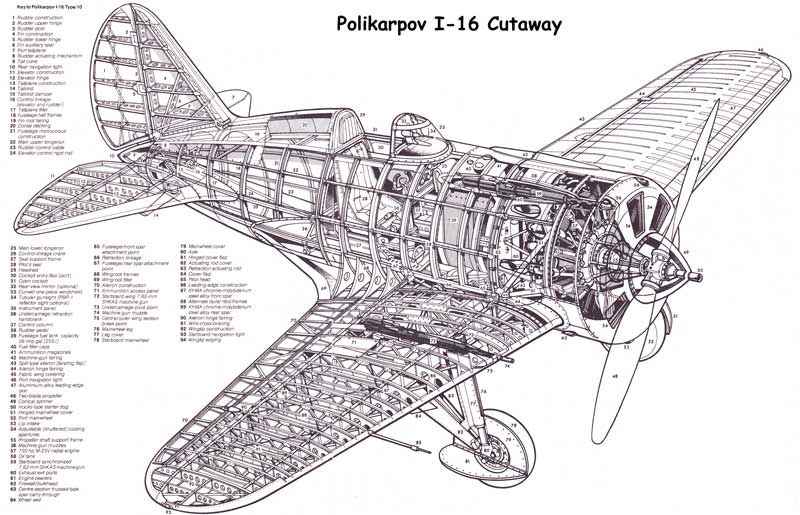 |
This fabulous Polikarpov I-16 cutaway comes in full size 8.5x11 PDF for FREE included in your MyModels folder! |
